Electron dot diagram Study guides, Class notes & Summaries
Looking for the best study guides, study notes and summaries about Electron dot diagram? On this page you'll find 88 study documents about Electron dot diagram.
All 88 results
Sort by
 Popular
Popular
-
Test Bank For Organic Chemistry 9th Edition by John E. McMurry
- Exam (elaborations) • 555 pages • 2023
- Available in package deal
-
- $33.23
- 1x sold
- + learn more
Chapter 01 - Structure and Bonding 1. Give the ground-state electron configuration for carbon (atomic number 6). 1s22s22px12py1 or 1s22s22p2 2. Give the ground-state electron configuration for fluorine (atomic number 9). ANSWER: POINTS: 1 1s22s22px2 2py2 2pz1 or 1s22s22p5 3. Give the ground-state electron configuration for magnesium (atomic number 12). 1s22s22p63s2 4. How many electrons does silicon have in its valence shell? ANSWER: four POINTS: 1 Exhibit 1-1 Write valid Lewis (elec...
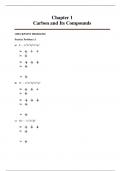 Popular
Popular
-
Solution Manual for Organic Chemistry Mechanistic Patterns Canadian 1st Edition Ogilvie Ackroyd Br
- Exam (elaborations) • 809 pages • 2024 Popular
-
- $48.48
- 1x sold
- + learn more
Chapter 1 Carbon and Its Compounds CHECKPOINT PROBLEMS Practice Problem 1.1 a) S — 1s2 2s2 2p6 3s2 3p4 b) Cl — 1s2 2s2 2p6 3s2 3p5 c) Na+ — 1s2 2s2 2p6 1-2 Copyright © 2018 Nelson Education Limited Practice Problem 1.2 a) Count valence electrons. Build a basic bonding framework and account for electrons used. Add remaining electrons and check for formal charges. The molecule has a lone pair on the nitrogen. All other electrons are bonding electrons. b) Count valence...
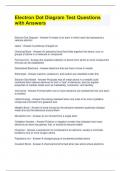
-
Electron Dot Diagram Test Questions with Answers
- Exam (elaborations) • 2 pages • 2024
- Available in package deal
-
- $12.99
- + learn more
Electron Dot Diagram Test Questions with Answers Electron Dot Diagram - Answer-A model of an atom in which each dot represents a valence electron cation - Answer-A positively charged ion Chemical Bond - Answer-An attractive force that holds together the atoms, ions, or groups of atoms in a molecule or compound. Formula Unit - Answer-the simplest collection of atoms from which an ionic compound's formula can be established Delocalized Electrons - Answer-electrons that are free to ...
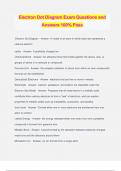
-
Electron Dot Diagram Exam Questions and Answers 100% Pass
- Exam (elaborations) • 2 pages • 2024
-
- $10.49
- + learn more
Electron Dot Diagram Exam Questions and Answers 100% Pass Electron Dot Diagram - Answer- A model of an atom in which each dot represents a valence electron cation - Answer- A positively charged ion Chemical Bond - Answer- An attractive force that holds together the atoms, ions, or groups of atoms in a molecule or compound. Formula Unit - Answer- the simplest collection of atoms from which an ionic compound's formula can be established Delocalized Electrons - Answer- electrons that are ...
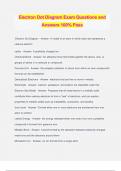
-
Electron Dot Diagram Exam Questions and Answers 100% Pass
- Exam (elaborations) • 2 pages • 2024
-
- $9.99
- + learn more
Electron Dot Diagram Exam Questions and Answers 100% Pass Electron Dot Diagram - Answer- A model of an atom in which each dot represents a valence electron cation - Answer- A positively charged ion Chemical Bond - Answer- An attractive force that holds together the atoms, ions, or groups of atoms in a molecule or compound. Formula Unit - Answer- the simplest collection of atoms from which an ionic compound's formula can be established Delocalized Electrons - Answer- electrons that are ...
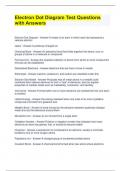
-
Electron Dot Diagram Test Questions with Answers
- Exam (elaborations) • 2 pages • 2024
- Available in package deal
-
- $8.79
- + learn more
Electron Dot Diagram Test Questions with Answers Electron Dot Diagram - Answer-A model of an atom in which each dot represents a valence electron cation - Answer-A positively charged ion Chemical Bond - Answer-An attractive force that holds together the atoms, ions, or groups of atoms in a molecule or compound. Formula Unit - Answer-the simplest collection of atoms from which an ionic compound's formula can be established Delocalized Electrons - Answer-electrons that are free to move...
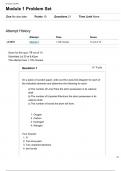
-
CHEM 219 Module 1 Problem Set Principles of Organic Chemistry with Lab Gallaher Portage Learning.
- Exam (elaborations) • 18 pages • 2024
- Available in package deal
-
- $11.99
- + learn more
CHEM 219 Module 1 Problem Set Principles of Organic Chemistry with Lab Gallaher Portage Learning. Score for this quiz: 10 out of 10 Submitted Jul 25 at 8:42pm This attempt took 1,135 minutes. Question 1 0 / 0 pts Your Answer: On a piece of scratch paper, write out the Lewis Dot Diagram for each of the indicated elements and determine the following for each: a) The number of Lone Pairs the atom possesses in its valence shell. b) The number of Unpaired Electrons the atom possesses in its...
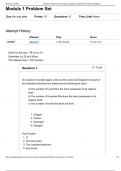
-
CHEM 219 Module 1 Problem Set: Principles of Organic Chemistry with Lab FALL 2023 Portage learning
- Exam (elaborations) • 18 pages • 2023
-
- $22.49
- + learn more
On a piece of scratch paper, write out the Lewis Dot Diagram for each of the indicated elements and determine the following for each: a) The number of Lone Pairs the atom possesses in its valence shell. b) The number of Unpaired Electrons the atom possesses in its valence shell. c) The number of bonds the atom will form. 1. Oxygen 2. Carbon 3. Hydrogen 4. Nitrogen 1. O 2. Two lone pairs 3. Two unpaired electrons 4. two bonds 12/14/23, 8:42 PM Module 1 Problem Set: Principles of Or...
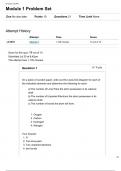
-
CHEM 219 Module 1 Problem Set Principles of Organic Chemistry with Lab Gallaher Portage Learning.
- Exam (elaborations) • 18 pages • 2024
- Available in package deal
-
- $11.99
- + learn more
CHEM 219 Module 1 Problem Set Principles of Organic Chemistry with Lab Gallaher Portage Learning. Score for this quiz: 10 out of 10 Submitted Jul 25 at 8:42pm This attempt took 1,135 minutes. Question 1 0 / 0 pts Your Answer: On a piece of scratch paper, write out the Lewis Dot Diagram for each of the indicated elements and determine the following for each: a) The number of Lone Pairs the atom possesses in its valence shell. b) The number of Unpaired Electrons the atom possesses in its...
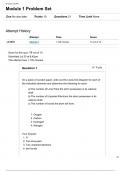
-
CHEM 219 Module 1 Problem Set Principles of Organic Chemistry with Lab Gallaher Portage Learning.
- Exam (elaborations) • 18 pages • 2024
- Available in package deal
-
- $12.99
- + learn more
CHEM 219 Module 1 Problem Set Principles of Organic Chemistry with Lab Gallaher Portage Learning. Score for this quiz: 10 out of 10 Submitted Jul 25 at 8:42pm This attempt took 1,135 minutes. Question 1 0 / 0 pts Your Answer: On a piece of scratch paper, write out the Lewis Dot Diagram for each of the indicated elements and determine the following for each: a) The number of Lone Pairs the atom possesses in its valence shell. b) The number of Unpaired Electrons the atom possesses in its...
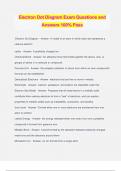
-
Electron Dot Diagram Exam Questions and Answers 100% Pass
- Exam (elaborations) • 2 pages • 2024
- Available in package deal
-
- $10.49
- + learn more
Electron Dot Diagram Exam Questions and Answers 100% Pass Electron Dot Diagram - Answer- A model of an atom in which each dot represents a valence electron cation - Answer- A positively charged ion Chemical Bond - Answer- An attractive force that holds together the atoms, ions, or groups of atoms in a molecule or compound. Formula Unit - Answer- the simplest collection of atoms from which an ionic compound's formula can be established Delocalized Electrons - Answer- electrons that are ...



